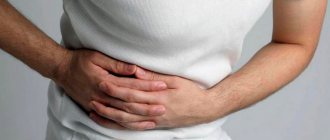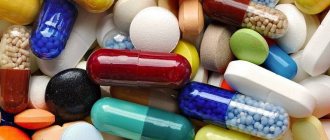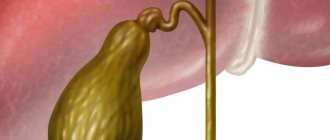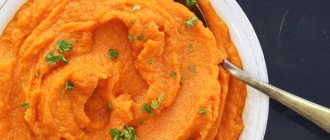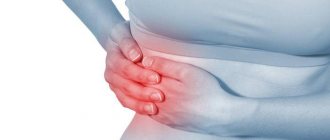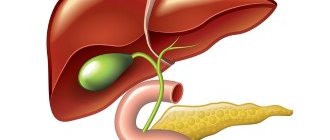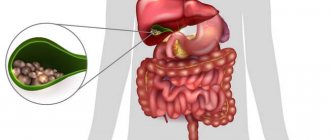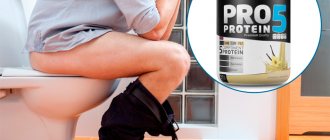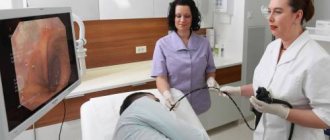Diarrhea after gallbladder removal is a common problem. The gallbladder is a pear-shaped reservoir for storing bile, which enters the duodenum, facilitating the digestion of food. Liberties in the diet can, over time, provoke stagnation of bile in the excretory tract, followed by the formation of stones, which may one day clog the duct. A disease such as cholecystitis develops, often ending in an operation to remove the organ (cholecystectomy).
Reasons for gallbladder removal
The gallbladder is an organ in which minerals and fluid are absorbed from bile. As a rule, inflammation occurs due to a violation of the outflow of bile. In 94-96% of patients hospitalized in the surgical department, cholelithiasis is detected. Treatment begins with medications. If there is no effect, surgery is performed to remove the gallbladder (cholecystectomy). Main reasons:
- Cholelithiasis.
- Acute or chronic inflammation of the gallbladder.
- Neoplasms.
- Traumatic injury.
- Purulent organ damage.
Human gallbladder
The gallbladder can be removed laparoscopically and openly. In the first case, instruments are introduced into the abdominal cavity through micro incisions. The operation is minimally invasive, reducing the number of complications and days of hospital treatment. Recovery takes less time. The scars are practically invisible. The cosmetic effect is especially important, since the pathology most often occurs in women. In many clinics around the world, 95-97% of patients are operated on laparoscopically.
An open operation to remove the gallbladder with an incision along the anterior abdominal wall is performed when diseases that were not recognized before cholecystectomy are detected (malignant or benign tumors in the gallbladder, stomach or colon) or complications (massive bleeding that cannot be stopped laparoscopically, damage to extrahepatic gallbladders). ducts).
Laparoscopy in gynecology is performed:
- for infertility, the cause of which has not been shown by non-invasive research;
- if hormonal therapy is ineffective for infertility;
- during surgery on the ovaries (if an ovarian tumor was removed, there were cysts, sclerocystosis);
- if there is a suspicion of endometriosis, adhesive disease;
- if the patient suffers from chronic pelvic pain;
- if there is endometriosis of the ovaries, uterine appendages, pelvic cavity;
- with myomatous lesions of the uterus;
- if the fallopian tubes were ligated, there was an ectopic pregnancy, or there was a rupture of the tube;
- with torsion of the cyst, ovary, ovarian apoplexy, with internal bleeding;
- during a pelvic examination.
https://youtu.be/C7JhzhWWSs4
Recovery after surgery
The postoperative period often passes without complications, but half of the patients develop digestive system disorders. Their entire set, including hologenic diarrhea, is combined into the concept of postcholecystectomy syndrome (PCES). The distinguished variants of PCES are:
- Dyspeptic (a feeling of bitterness in the mouth, especially on an empty stomach, nausea, diarrhea or constipation).
- Painful (constant pain in the right hypochondrium of varying intensity).
- Jaundice (periodic jaundice of the skin and sclera, combined with or without pain in the right hypochondrium).
- Clinically asymptomatic (the patient has no complaints, but according to ultrasound and biochemical blood tests, pathological changes are determined).
Postcholecystectomy syndrome
The results of a study by the Central Research Institute of Gastroenterology (Moscow) showed that the first option is the most common.
Normally, bile is produced continuously and accumulates. Excretion in portions depending on the volume of food depends on the gallbladder. The human body produces approximately 1-1.8 liters of bile, which, when concentrated, enters the intestines after meals to break down and absorb fats and activate pancreatic enzymes. Bile is associated with the breakdown of proteins and carbohydrates, the absorption of fat-soluble vitamins, and inorganic salts. Under the influence of bile, the acid and enzymes of gastric juice are inactivated.
After surgical removal of the organ, the mechanisms that regulate the release of hepatic bile into the lumen of the duodenum disappear. Regardless of whether there is food in the intestines or not, intake occurs constantly. Bile acids act as a laxative, increase fluid secretion, and stimulate peristalsis. The small intestine contracts more often, and the passage of food through the intestinal tube accelerates. The consistency of stool and color changes. The stool is homogeneous green-yellow or with greens and admixtures of undigested food particles due to bile contents.
There are several ways to help the body digest food in new conditions:
- Reduce the amount of food.
- Eat more frequently during the day.
- Change your diet (reduce the amount of fats and foods that affect peristalsis).
The severity of diarrhea is determined by the concentration of bile coming from the liver, a feature of the autonomic nervous system and intestines.
Patient prognosis
The problem of diarrhea after gallbladder removal is common and unpleasant. Complaints may recur years after surgery. Scheduled consultations with a therapist and gastroenterologist are needed for timely correction of treatment. In an adult patient, self-control is important. Changing your lifestyle and diet is the key to successful treatment.
The gallbladder performs many important functions in the digestive system. It collects 2 liters of bile daily, which, entering the intestines, emulsifies fats. The gallbladder is inextricably linked with other organs. Bile comes into it from the liver, and it itself has a positive effect on intestinal motility.
Externally, the gallbladder resembles a pouch. Since a number of diseases of this organ cannot be treated conservatively, the gallbladder is often removed. Such surgery has a number of consequences, many of which are not always pleasant.
Diarrhea after cholecystectomy
Hologenic diarrhea is diarrhea three or more times a day after cholecystectomy. Chronic bowel dysfunction lasts more than four weeks. In most patients, bowel movements return to normal, but this takes time. An unpleasant symptom slows down the return to the original level of activity.
Frequent loose stools are an uncomfortable condition, but not dangerous to health. With massive fluid loss, dehydration and electrolyte imbalance may occur. If “symptoms of anxiety” appear, you need to consult a surgeon and therapist:
- Blood in the stool.
- Fever.
- Abdominal pain.
- Weight loss.
- Constant thirst.
- Cramps of the calf muscles.
- Diarrhea for more than four weeks.
Several episodes of diarrhea after surgery do not require additional tests or examinations. If other symptoms appear, diagnosis is carried out according to indications.
Traditional methods
Before being treated with traditional methods, you should find out from your doctor which of them are the safest and most effective, whether they have contraindications and whether there is a likelihood of side effects. These are mainly products that affect peristalsis and normalize intestinal function:
- freshly squeezed beet juice in an amount of 500 ml is drunk in small portions throughout the day;
- potato juice also affects intestinal function; it must be taken on an empty stomach before each meal;
- prunes and other dried fruits;
- vegetable oils, a teaspoon on an empty stomach before meals;
- carrot or pumpkin juice;
- Senna herb decoction.
After surgery to remove the gallbladder, you should not experiment with unknown folk methods. More attention should be paid to proper nutrition and preparing healthy food.
Treatment of hologenic diarrhea
The main goals of therapy are to restore the normal biochemical composition of bile, the function of the biliary tract and minimize the continuous effect of bile acids on the small intestine. In most cases, following the recommended regimen and diet leads to recovery. The need to prescribe medications is determined by the doctor in each specific case.
Postoperative regimen
After laparoscopic surgery, on the first or second day you are allowed to walk for 30-40 minutes daily, do breathing exercises and exercise therapy. Lifting weights more than 5 kg in the first 7-10 days is contraindicated. After 4-6 months, the range of physical activity expands, running and working out the abdominal muscles are added. The recovery time is determined by the presence or absence of complications, the initial level of physical fitness, and concomitant pathology.
Features of nutrition with a removed gallbladder
To prevent bile from accumulating in the ducts, food should be eaten frequently and in small portions. The optimal number of meals is 5-7 per day. The volume of the main portion is 200-250 ml. Be sure to have 2-4 snacks. Fats are limited to 60-70g per day.
For hologenic diarrhea in the early postoperative period, American therapists recommend the “BRATTY” diet. It includes bananas, rice, apples (preferably baked), weak tea, dry day-old bread and biscuits, and natural yogurt. It is important to drink enough fluids to prevent the opposite problem - constipation.
Following a number of recommendations will help improve the quality of life after surgery:
- Reduce the amount of fatty and fried foods. Steam, stew or boil food. There is no need to completely eliminate fats from your diet. In one meal, 3 grams of fat are digested. Larger amounts cause dysmotility and bloating.
- Increase fiber intake over 2-4 weeks. Include cereal porridges, whole grain flour products in your diet, add butter and vegetable oil. A sharp increase in fiber leads to gas formation.
- For protein products, low-fat fish (hake, pollock) and lean meat (chicken, quail, rabbit, beef) 1-2 times a week are recommended. Reduced-fat dairy products (cottage cheese, kefir, yogurt) are offered for snacks and dinner.
- The diet should include vegetables, fresh stewed and baked. Fermented and pickled foods are not recommended to prevent bloating.
- Coffee worsens the symptoms of diarrhea, so it is better to avoid it. Replace sweets with non-sour fruits and honey.
Drug correction of diarrhea
Diarrhea syndrome should be treated depending on the severity and accompanying complaints. To prevent electrolyte disturbances in the acute period, rehydration solutions are prescribed (Regidron, Ionica, Bio Gaia ORS). Probiotics (Enterozermina, Enterol, Linex) help normalize the intestinal microflora. To treat painful spasms, antispasmodics (Mebeverine hydrochloride) and choleretic drugs are prescribed. Herbal preparations containing silymarin (Gepabene, Essentiale, Karsil, Darsil) normalize liver function.
If signs of inflammation are detected, antibiotics are required (Erythromycin, Clarithromycin, Ciprofloxacin). To weaken motor skills, loperamide (Imodium, Lopedium) is used. Enzyme deficiency can cause diarrhea, flatulence, and heaviness in the stomach. Creon (Pangrol, Panzinorm, Ermital) helps replenish enzyme deficiency and facilitate the digestion of food. With diarrhea, the absorption of nutrients is limited, so vitamin and mineral complexes containing omega 3 fatty acids, magnesium, and vitamins B and C are prescribed.
Without lifelong adherence to a diet and regimen, drug therapy is ineffective.
Irritation from diarrhea
Hologenic diarrhea causes damage to the skin of the anus from bile and irritating acids. A few rules will help alleviate the painful condition.
- After bowel movements, do not rub, but soak. Use baby wipes instead of toilet paper.
- Apply a thin layer of baby protective cream against diaper dermatitis to the anus. The barrier will protect irritated skin from the action of bile acids.
- Avoid hot spices and herbs. Stimulating bile secretion will lead to more irritation.
- Keep a food diary. This way you can mark dishes that provoke an unpleasant symptom.
Nutrition adjustments
In case of stool disorders, the diet often changes and special diets must be used. Hologenic diarrhea is no exception; in addition, adjusting the diet in this condition is a prerequisite.
The nutritional rules are very simple:
- You should eat small portions and often, about 6 times a day.
- You need to give up heavy foods and dishes, especially in large quantities. This allows you to relieve and facilitate the work of the digestive system. To do this, you should avoid fatty foods, fried foods, spicy and salty foods, as well as other unhealthy foods.
- During the diet, you need to give up fast food, soda and alcohol.
- You also need to exclude onions, garlic, tomatoes and various spices from the menu, which can irritate the mucous membranes.
- To normalize stools and quickly recover, you need to prepare and eat slimy porridges, light soups and broths. Only dietary meat is allowed; it is recommended to eat only boiled fruits that are not sour, and also eat fully ripened vegetables.
- It is important to eat only warm foods and dishes when treating the disorder. Cold food greatly irritates the gastrointestinal tract and also worsens the condition.
Diarrhea is hologenic and its treatment consists of large and proper consumption of water. For this, patients are recommended to drink 2 liters a day or more.
This allows you to maintain normal water balance. The tips described should be used throughout the entire therapy.
When you no longer need to take medications and hologenic diarrhea goes away, you should not immediately eat fatty and other unhealthy dishes and foods.
You need to stick to the diet for 2-3 weeks. If left untreated, the disorder will develop into a chronic form, after which additional complications will appear.
Diet to help avoid constipation
People who have had their gallbladder removed are advised to completely change their diet for several months. In the first few days, solid food is contraindicated; the patient can only consume liquids, vegetable decoctions, tea and pureed purees. Then gradually include all products except those that may negatively affect the functioning of the digestive tract. Liquid soups and cereals, vegetables and fruits will be useful.
For several months after the intervention, you should avoid the following foods:
- fatty, fried foods, smoked foods;
- fresh bread and pastries;
- carbonated drinks and alcohol;
- cold foods (ice cream).
Constipation after gallbladder removal is not uncommon. Patients complain of intestinal disorders even if they follow all the doctor’s recommendations. During the recovery period, it is necessary to follow the doctor’s instructions, adhere to a diet and normalize physical activity. In extreme cases, you can use medications: laxative tablets, suppositories or enemas. In most cases, all symptoms disappear within a few months, and the patient can return to their normal lifestyle.
After removal of the gallbladder, 50% of patients develop unpleasant symptoms. Every fifth person suffers from loose stools. Accelerated passage of food through the intestinal tract is a complication of surgery or a pathology that was not diagnosed before cholecystectomy. Stool returns within 1-2 weeks, but diarrhea can persist for years.
